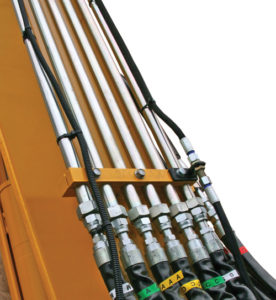By David Marlowe • Owner/CEO • DMAR Technical Training and DMAR Business Centers USA
In the last article, we discussed breaking the hydraulic circuit into three sections. Now, we will discuss one of the options to what connect the three sections of a hydraulic circuit—hydraulic piping and fittings.
Steel pipe is commonly used as a fluid conductor especially when large volumes of fluid are moved or when the cost relative to the use of tubing is considered. The basic hydraulic circuit uses seamless carbon steel piping. It is of the utmost importance that attention to detail be used when selecting piping to be used in your circuit, and that all piping be free from all dust, rust and all residual left over from the manufacturing processes. Because steel is subject to rusting, the piping has a standard finish of a lacquer coating to protect the metal surfaces, especially during shipping and storage. This process is known as “black iron pipe.” Pickled and oiled or pickled only are the preferred finish for hydraulic system piping. It is important to remember that galvanized pipe is not recommended for use in hydraulic systems, therefore should never be used.
When sizing a pipe one should remember that the “Nominal Pipe Size” (NPS) is the system that is used. For pipes up to 12 in., the inside diameter is smaller than the outside diameter. For example, a pipe with a 5-in. ID would have an OD of 5.5 in. For in. For pipe sizes greater than 12 in., the NPS refers to the OD. For example, a 13-in. pipe will have a 13-in. ID.
Commercial grade carbon steel pipe comes in standard sizes 1⁄8 to 42 in. Each pipe size is available in a variety of wall thicknesses. Because the specified OD is standard and remains constant, a thicker wall thickness will change the pipe ID. When selecting pipe for specific applications, the wall thickness must be considered to allow for proper fluid flow. Improper pipe ID will create a large pressure drop in that section of piping. Remember, whenever you have a pressure drop without any work being accomplished, you will have an increase in heat.
Wall thickness is expressed as a schedule number, otherwise known as pipe weight. NPS 1 inch:
- Light Wall: schedule #10
- Standard: schedule #40
- Extra Strong: schedule #80
- Extra, Extra Strong: Schedule #160
Schedule #40 is the most commonly used for hydraulic systems at most plants because of its availability and has the minimum wall thickness needed for use in a hydraulic system.
Hydraulic fittings
I often ask my students why they install flanges and fittings in any system. When I explain that the installation of flanges and fittings in a system is for our benefit, I get a puzzled look. Flanges and fittings will give us access to parts of a system without having to cut and dismantle sections to acquire access to that part of the system. They just make our job easier. The attention to detail when working with flanges or fittings is just as important as the attention to detail we pay the piece of equipment we are removing for repair.
Pipe fittings are made in a variety of materials. Forged steel fittings are the most suitable for use in hydraulic applications. Fittings are attached to the pipe by:
- welded joint: socket weld, butt weld
- threaded fitting: screw thread
Welded joints are more commonly used where higher pressures and vibration are present, where the transition between the pipe and fitting must be smooth and where oil leaks cannot be tolerated.
The socket weld is usually used for pipes 2 in. and under, and are produced in three pressure designations:
- Class 3000
- Class 6000
- Class 9000
Pressure and temperature ratings for each of the above class fittings are equal to the following schedule pipe:
- Class 3000 schedule 80 weight XS
- Class 6000 schedule 160
- Class 9000 weight XXS
The butt weld is used for larger size pipes, and it is required to have identification markings on each fitting.
Butt weld fitting identification is as follows:
Example: ABC 6 in. STD WPB 14N2
- ABC: manufacturers’ name
- 6 in.: size
- STD: schedule or wall thickness
- WPB: material designation
- 14N2: melt identification or lab control number
Threaded fittings are most common and are used on smaller pipe sizes with pressures up to 2,500 psi.
Forged steel threaded fittings are produced in one of the following three pressure designations:
- Class 2000
- Class 3000
- Class 6000
Pressure and temperature ratings for each of the above class fittings are equal to the following schedule pipe:
- Class 2000 schedule 80 weight XS
- Class 3000 schedule 160
- Class 6000 weight XXS
Pipes can only have male threads because the wall thickness varies. The pipe thread form used for pressure joints in North America is the American National Standard Taper Pipe Thread (NPT).
The NPT taper has a 1 in 16 taper (3⁄4 in. per foot) on the diameter and a 60° thread form.
DMAR Technical Training
dmartechtraining.biz
The post When should you use hydraulic piping and fittings? appeared first on Hose Assembly Tips.
Filed Under: Fittings, Couplings & Adapters, Hose & Tubing, Hose Assembly Tips
